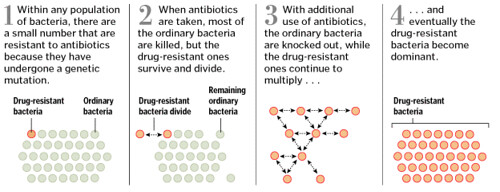One of the little things I liked about Rick Weiss' cefquinome article was a diagram about how antibiotic resistant strains evolve.
One of the confusing things about the evolution of resistance (and natural selection, for that matter) is the notion that the evolution of resistance happens among individuals within populations. This graphic from the Washington Post lays that out quite nicely:

It might be good for students too.
More like this
Yes, this is O157:H7, not ExPEC. Bully for you.
While many laboratory experiments have shown that antibiotic resistance imposes a fitness cost on resistant bacteria, it's far less clear if this is the case in natural populations.
Yesterday, four people emailed me, asking about Brian Palmer's Slate article about antibiotic resistance. Since I'll probably get more such emails (and thank you for sending them), I'll offer my thoughts below:
I've written before about antibiotic resistance in the developing world.

Sohbet
Chat
dankee
Bacteria can pass resistance to each other via plasmids right?
Steven,
yes, but the rate of plasmid transfer is usually very low, so, in effect, it should be thought of as a funky kind of mutation. In other words, plasmid transfer isn't infectious, in the way that a virus is.
As with all things in biology, there are obviously exceptions.
There are chemical signals that increase the rate of plasmid transfer. I don't know if antibiotics have this kind of effect, but I wouldn't be surprised if some do.
(I used to work on this - except the transfer was from bacteria to plants.)
thanks
(I used to work on this - except the transfer was from
There are chemical signals that increase the rate of plasmid transfer. I don't know if antibiotics have this kind of effect, but I wouldn't be surprised if some do.
There are chemical signals that increase the rate of plasmid transfer. I don't know if antibiotics have this kind of effect,
rate of plasmid transfer. I don't know if antibiotics
I recall reading an article that said the opening shots in the next world war would be in cyberspace, with dodgy spambots flooding the net.
Either that or its viral marketing.
thanks for all
kurye, kuryeler, hızlı kurye, yaya kurye, acıl kurye, kadikoy kurye, istanbul kurye, motor kurye, arac kurye
One of the confusing things about the evolution of resistance (and natural selection, for that matter) is the notion that the evolution of resistance happens among individuals within populations. This graphic from the Washington Post lays that out quite nicely:
good job..
thank you very much
thanks
thank you
thanks for you
sex shop
biber hapı
I recall reading an article that said the opening shots in the next world war would be in cyberspace, with dodgy spambots flooding the net.